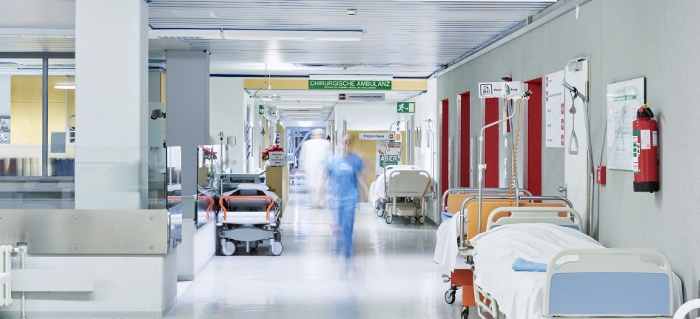
A major part of radiologist’s work involves the handling of very large images, generated by MRI, CAT scans and X-Rays, and is digitally stored on a Patient Archiving and Communications System (PACS) platform. In Ireland, NIMIS is a system for storing and retrieving medical imaging studies in comprising a national Radiology Information System (RIS) and Patient Archiving & Communication Service (PACS), with imaging studies stored both locally and at a central data repository.
The platform is accessed via specific workstations for recording diagnostics, and other purposes. The radiologists also access the patient health records, such as blood tests lab test, etc., in order to dictate and submit reports.
The National Integrated Medical Imaging System (NIMIS) in Ireland, was established by the Ireland Health Service (HSE) back in 2010, for 35 different hospitals around the country and is used by most radiologists around the country.
One of the initiatives initiated at the St. James’s Hospital, Dublin, has been to encourage and enable some of the healthcare staff to work efficiently from home. For Dr Niall Sheehy, the hospital’s Consultant Radiologist, this has been a game changer, thanks to the network architecture put in place by the IT team. This foresight has been instrumental in ensuring security, and the safety of the radiologists during the COVID-19 confinement period. It has also ensured continuity of service for this critical service. But accessing the confidential data and having a high-performance remote work experience require a number of technical challenges to be overcome.
Due to the very large number of high-resolution images and the associated volume of data, the required speed for access to this information, and the numerous system which radiologists need to interact with, it has been very difficult to interpret images and patient information anywhere else other than in the hospital. This means that if a radiologist is on call and needs to address a case, they would have to drive in and sit behind one the many workstations dedicated to this task.
“During the COVID-19 isolation period, this has become an even more critical constraint,” Dr. Sheehy points out, “especially if a doctor or radiologist needs to self-isolate for 14 days following suspected exposure to the virus. The hospital would simply be deprived of their radiologist who would be confined to their home and unable to function due to the lack of remote access to the system.”

The hospital have tried several ways to enable Dr Sheehy and his team to work from home. But none of these have been satisfactory. Techniques involving virtual desktops, or remote desktops not yielded the expected results, leading to low resolution images and high latency when accessing information and making it difficult to make effective diagnostics. Even a full replica of a workstation at home via a standard VPN tunnel has not delivered the required results and still doesn’t solve the challenge of allowing interaction with other hospital systems.
“The only way to ensure a secure and seamless remote working experience, is to extend the hospital network to the remote location, or to the home,” says Dr Sheehy.
This ensures secure access, but also seamless connectivity and interaction with other hospital resources and platforms, including the EPR.
“What Aruba has enabled us to do is to put Remote Access Points or RAPs in our homes, for us to be able to use an exact replica of a PACS workstation which is directly plugged into the RAP,” says Sheehy, “even with a very low latency due to the standard broadband service, still allows us to have full functionality and access to services, even if it take a little longer to download images.”
Dr Sheehy believes that during periods such as the COVID-19 pandemic, such a capability will be a valuable feature in the services that the hospital IT and HSE can provide to clinical staff who can work remotely. But even under normal circumstances, whether staff are on leave or duty and need to tend to an emergency, it will be far more efficient for the patients, the hospital and for them to benefit from this remote access.
“We’ve now deployed eight RAPs for our staff now and my colleagues have been able to use the RAPs with no training required at all,” says Sheehy “and we’re now beginning to equip our cardiologists who would need access to very similar systems.”
For John Nolan, Networks Manager at St. James’s Hospital, ensuring security of access to the hospital network and ensuring the quality of service for Dr Sheehy and his colleagues are two important priorities. At the same time, John Nolan and his IT team also use Aruba RAPs from home in order to remotely monitor the network and ensure its operation and availability at any time.
“We also use the RAPs at home. They allow us to extend the same security rules and access policies that we have in the hospital, to the staff’s home,” Nolan points out. “This is critical as we can then ensure that they have the same level of access to the PACS or other patient records. Their workstations are connected to the RAP and, even though at home, no one else can use that network for any form of access.”
The RAP tunnels into the hospital's Aruba gateway via secure VPN. The users and their devices are authenticated through the same policies which the gateway applies to connections within the hospital. The policies and security processes are defined and orchestrated by Aruba ClearPass.
The main campus network at St. James’s Hospital, and the RAP solution was a joint implementation between Aruba Platinum partner, Vodafone Ireland, and HPE-Pointnext. The solution is supported by Vodafone.
In future, other use cases can be imagined around the RAPs to create a more inclusive home office environment for Dr Sheehy and his other colleagues. For example, they can connect an IP Phone to the RAP network and benefit from their hospital IP-Telephony service.
For researchers and medical students and other staff who need access to eduroam, one possibility for John Nolan and his team is to extend EDUROAM to the home, via the Aruba RAP. “This is certainly a possibility, but we first need to replicate eduroam on the hospital network,” says Nolan. “But we have a lot of priorities and this is another one which needs to be put on the list.”
Related Content
Read how other organizations are meeting business continuity challenges.




